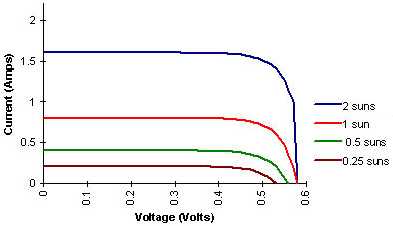Solar Cells
Shedding a little light on
photovoltaics -- 28 February, 2002
|
|
|
|
|
|
|
||
|
 Figure 6 -- Single-junction solar cell I/V curves (diagram courtesy ACRE ) A solar cell's power output can be characterized by two numbers -- a maximum Open Circuit Voltage (Voc, measured at zero output current) and a Short Circuit Current (Isc, measured at zero output voltage). Remember that power can be computed via this equation: So with one term at zero these conditions (V = Voc @ I = 0; V = 0 @ I = Isc) also represent zero power. As you might then expect, a combination of less than maximum current and voltage can be found that maximizes the power produced. This condition is called, not surprisingly, the "maximum power point". BEAM solar engine designs attempt to stay at (or near) this point. The tricky part is building a design that can find the maximum power point regardless of lighting conditions2. Note that single junction silicon solar cells produce approximately 0.5 - 0.6 Voc, so they are usually connected together in series to provide larger voltages. In some cases (like the Panasonic Sunceram cells), multiple cells are built onto a single substrate in order to yield the convenience of higher output voltage from a single package. Some more subtle properties of solar cells also need to be accounted for in their use. In particular, when connecting solar cells in series, care needs to be taken to give all cells roughly equal access to light -- the weakest solar cell in series (or one that is shaded) will determine the total current. Normally this is not an issue in BEAMbots, and will only rear its ugly head if you spread solar cells around on the surface of your 'bot. In a pinch, reverse Schottky diodes can be wired across each cell to automatically bypass any cell that may get shaded.3 Similar issues can occur when wiring solar cells in parallel. In that case a shaded cell can act as a short circuit to the output of its more active neighbors. Here, a germanium diode in series with each separate cell can be used to mitigate problems, if 'bot geometry can't be adjusted to avoid them (although at the cost of a few tenths of a volt). A wide variety of cells are available for your purchase. Rather than repeating a large amount of solar cell selection and comparison information, the reader is directed to consult the solar cell section of the BEAM Reference Library's BEAM Pieces collection for help in deciding which cells to buy.
Notes: 1. One result of this is that
while testing a circuit, you can simulate a solar
cell with a current source. |
|
|
|
|
|
|
|
||
|
|
This page was last updated on |
|